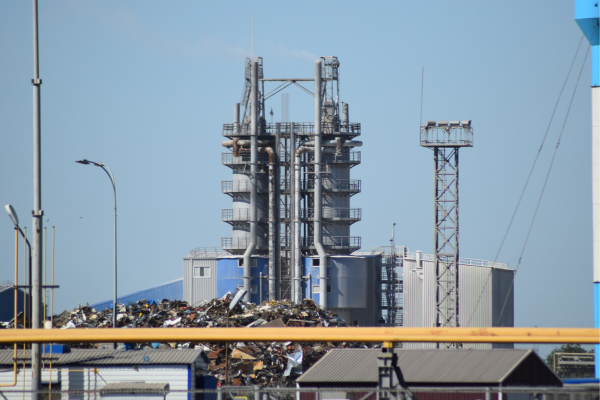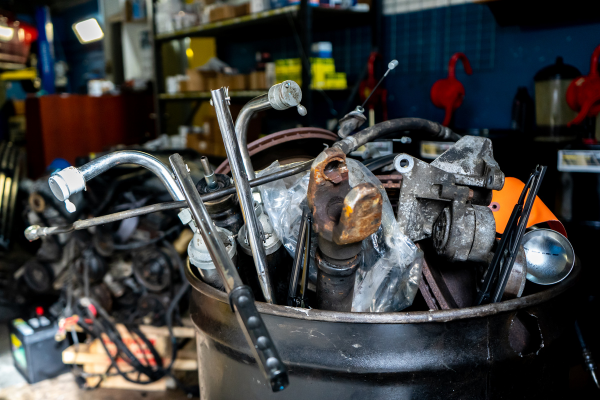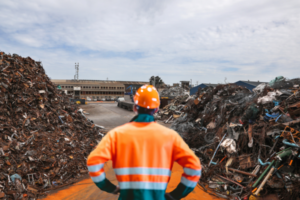Introduction
Scrap metal recycling is the process of collecting, sorting, processing, and reusing metal materials that have reached the end of their useful life. This practice has been around for centuries, with evidence of metal recycling dating back to ancient times. The concept of recycling scrap metal involves extracting valuable metals from discarded items and transforming them into new products. This not only helps to conserve natural resources but also reduces the need for mining and manufacturing new metals.
Table of Contents
The Importance of Scrap Metal Recycling
The act of recycling scrap metal is essential for maintaining the health of our environment and advancing the principles of sustainability. One of the key benefits is the conservation of natural resources. By recycling scrap metal, we can reduce the demand for raw materials such as iron ore, aluminum, and copper. This helps to protect natural habitats and ecosystems that would otherwise be disrupted by mining activities.
Furthermore, scrap metal recycling contributes to the reduction of greenhouse gas emissions. The production of metals from virgin materials requires a significant amount of energy, which often comes from fossil fuels. By recycling scrap metal, we can save energy and reduce carbon dioxide emissions associated with the extraction and processing of new metals.
In addition to environmental benefits, there are also economic advantages to scrap metal recycling. The industry provides employment opportunities and contributes to local economies through the sale of recycled metals. Moreover, recycling scrap metal reduces waste disposal costs for businesses and municipalities, as it diverts materials from landfills.
Types of Scrap Metal
Scrap metal can be broadly categorized into three main types: ferrous metals, non-ferrous metals, and precious metals.
Metals that are ferrous, like steel and cast iron, are those which contain iron. These metals are widely used in construction, automotive manufacturing, and appliances due to their strength and durability. Ferrous scrap metal is commonly found in old cars, machinery, and structural components.
Non-ferrous metals do not contain iron and are highly resistant to corrosion. Some non-ferrous metals are aluminum, copper, brass, and lead. These metals are commonly used in electrical wiring, plumbing, and various industrial applications. Non-ferrous scrap metal can be found in discarded electronics, plumbing fixtures, and automotive parts.
Precious metals like gold, silver, and platinum are prized for their scarcity and distinctive characteristics. These metals are often used in jewelry, electronics, and dental applications. Precious metal scrap can be obtained from old jewelry, electronic components, and dental restorations.
Steps To Scrap Metal Recycling
Collection and Sorting of Scrap Metal
| Metrics | Description |
| Weight of collected scrap metal | The total weight of scrap metal collected over a certain period of time |
| Collection Efficiency | The percentage of scrap metal that is successfully collected compared to the total amount available. |
| Sorting Accuracy | The percentage of scrap metal that is correctly sorted into different categories such as ferrous and non-ferrous metals. |
| Number of scrap metal items collected | The total number of individual scrap metal items collected |
| Types of scrap metal collected | The different types of scrap metal collected, such as copper, aluminum, steel, etc. |
| Sorting Speed | The amount of time it takes to sort a given amount of scrap metal. |
| Revenue Generated | The total amount of money earned from selling the sorted scrap metal. |
The collection of scrap metal can occur through various sources, including industrial waste, construction sites, demolition projects, and consumer discards. Industrial waste generated during manufacturing processes often contains valuable metal residues that can be recycled. Construction sites and demolition projects yield large quantities of scrap metal from structures and equipment that are being replaced or demolished. Consumer discards, such as old appliances and vehicles, also contribute to the scrap metal supply.
Methods of collecting scrap metal range from individual drop-off centers to large-scale collection programs. Recycling centers and scrapyards are common collection points where individuals can bring their scrap metal for recycling. Some municipalities also provide curbside collection services for specific types of scrap metal.
Once collected, the sorting of scrap metal is essential to separate different types of metals for further processing. Sorting techniques include manual sorting by trained workers or automated processes that utilize magnets, eddy currents, and optical sensors to identify and separate different metals based on their magnetic properties or conductivity.

Transportation of Scrap Metal
Transporting scrap metal from collection points to recycling facilities requires careful planning and consideration for safety and efficiency. Various modes of transportation can be utilized depending on the quantity and type of scrap metal being transported.
For smaller quantities or shorter distances, trucks are commonly used to transport scrap metal. Trucks offer flexibility in terms of routes and can access areas that may be inaccessible to larger vehicles. However, for larger quantities or longer distances, rail or barge transportation may be more cost-effective and environmentally friendly.
Safety considerations are paramount when transporting scrap metal. Proper securing and containment of the materials are essential to prevent accidents and spills. Additionally, compliance with local regulations and permits is necessary to ensure the safe transportation of hazardous materials, such as lead-acid batteries or mercury-containing devices.
Processing of Scrap Metal
Once the scrap metal reaches the recycling facility, it undergoes a series of processing steps to prepare it for further recycling. Different metals may require varying processing techniques based on their type and intended application.
Preparation for shredding and melting is a common step in scrap metal processing. This involves removing any non-metallic attachments, such as plastic or rubber, from the metal components. Mechanical processes, such as crushing or shearing, are often employed to break down larger pieces into smaller, more manageable sizes.
Removal of impurities is another crucial step in the processing of scrap metal. Impurities can include dirt, paint, coatings, or other contaminants that may affect the quality of the recycled metal. Techniques such as washing, chemical treatments, or heat treatments are used to remove these impurities and ensure the purity of the recycled metal.
Shredding and Melting of Scrap Metal
Shredding is a common method used to further break down scrap metal into smaller pieces before melting. Shredders are powerful machines that use rotating blades or hammers to tear apart the metal components. This process increases the surface area of the metal, making it easier to melt and separate any remaining impurities.
Melting is the final step in transforming scrap metal into a usable form. The shredded metal is placed in a furnace or smelter where it is heated to high temperatures until it reaches its melting point. Once melted, any remaining impurities, such as slag or dross, can be skimmed off the surface or separated through various refining techniques.
Purification and Refining of Scrap Metal
After the initial melting process, further purification and refining may be necessary to achieve the desired quality and composition of the recycled metal. This is particularly important for precious metals, where even small impurities can significantly affect their value and properties.
The removal of remaining impurities can be achieved through various methods, including chemical treatments, electrolysis, or fractional distillation. These techniques selectively separate impurities from the molten metal based on their chemical properties or boiling points.
Refining techniques are employed to further enhance the quality and purity of the recycled metal. For example, refining processes may involve adjusting the composition of alloys or removing specific elements to meet specific industry standards or customer requirements. Refining can be achieved through processes such as alloying, degassing, or vacuum distillation.
Reuse and Repurposing of Scrap Metal
Recycled scrap metal can be transformed into a wide range of new products, contributing to a circular economy where materials are reused and repurposed rather than discarded. The versatility of recycled scrap metal allows it to be used in various industries and applications.
Examples of products made from recycled scrap metal include new cars, appliances, construction materials, packaging materials, and even artwork. The automotive industry, in particular, relies heavily on recycled scrap metal for manufacturing new vehicles. Recycled steel and aluminum are used to produce car bodies, engine components, and other parts.
The use of recycled scrap metal offers several benefits. Firstly, it reduces the demand for virgin materials, conserving natural resources and reducing the environmental impact associated with mining and extraction. Secondly, using recycled scrap metal requires less energy compared to producing metals from raw materials. This helps to reduce carbon emissions and combat climate change. Lastly, using recycled scrap metal often results in cost savings for manufacturers, making it an economically viable option.
Environmental Benefits of Scrap Metal Recycling
Scrap metal recycling provides significant environmental benefits, contributing to the reduction of landfill waste, conservation of energy, and the mitigation of greenhouse gas emissions.
By recycling scrap metal, we divert a substantial amount of waste from landfills. Metal items that are not recycled often end up in landfills, where they can take hundreds of years to decompose. By keeping these materials out of landfills, we reduce the strain on limited landfill space and minimize the potential for soil and water contamination.
The recycling of scrap metal also helps to conserve energy. The production of metals from virgin materials requires a significant amount of energy, including the extraction, transportation, and processing stages. By recycling scrap metal, we save energy that would otherwise be consumed in these processes. For example, recycling aluminum requires only about 5% of the energy needed to produce aluminum from bauxite ore.
Furthermore, scrap metal recycling contributes to the reduction of greenhouse gas emissions. The extraction and processing of metals from raw materials are energy-intensive processes that often rely on fossil fuels. By recycling scrap metal, we reduce the need for these energy-intensive processes and subsequently decrease carbon dioxide emissions. It is estimated that recycling one ton of steel can save approximately 2,500 pounds of iron ore, 1,400 pounds of coal, and 120 pounds of limestone.
Future of Scrap Metal Recycling
The future of scrap metal recycling looks promising, with advancements in technology and the potential for growth in the industry.
Advancements in technology have improved the efficiency and effectiveness of scrap metal recycling processes. For example, automated sorting systems utilizing advanced sensors and artificial intelligence algorithms can identify and separate different types of metals more accurately and efficiently. This reduces the need for manual sorting and increases the overall productivity of recycling facilities.
Additionally, advancements in metallurgical processes have enabled the recycling of more complex metal alloys and composites. These processes allow for the recovery of valuable metals from electronic waste, which contains a wide range of metals and materials. As technology continues to evolve, the recycling of electronic waste is expected to become more efficient and economically viable.
The potential for growth in the scrap metal recycling industry is significant. As awareness of environmental issues and sustainability continues to grow, there is an increasing demand for recycled materials. Governments and organizations around the world are implementing policies and initiatives to promote recycling and reduce waste. This creates opportunities for the expansion of scrap metal recycling facilities and the development of new technologies to improve the recycling process.
Conclusion
Scrap metal recycling is a vital practice that contributes to environmental preservation, resource conservation, and economic benefits. The process involves collecting, sorting, processing, and reusing metal materials that have reached the end of their useful life. By recycling scrap metal, we can conserve natural resources, reduce greenhouse gas emissions, and minimize waste disposal costs.
The types of scrap metal include ferrous metals, non-ferrous metals, and precious metals. These metals can be obtained from various sources such as industrial waste, construction sites, and consumer discards. The collection and sorting of scrap metal are essential steps in the recycling process, followed by transportation to recycling facilities.
Once at the facility, scrap metal undergoes processing steps such as shredding and melting to prepare it for further recycling. Purification and refining techniques are employed to remove impurities and enhance the quality of the recycled metal. The recycled scrap metal can then be reused and repurposed in various industries, offering environmental benefits and cost savings.
Scrap metal recycling provides significant environmental benefits by reducing landfill waste, conserving energy, and mitigating greenhouse gas emissions. The future of scrap metal recycling looks promising with advancements in technology and the potential for growth in the industry. Continued efforts in recycling scrap metal are crucial for a sustainable future where resources are conserved, and waste is minimized.




